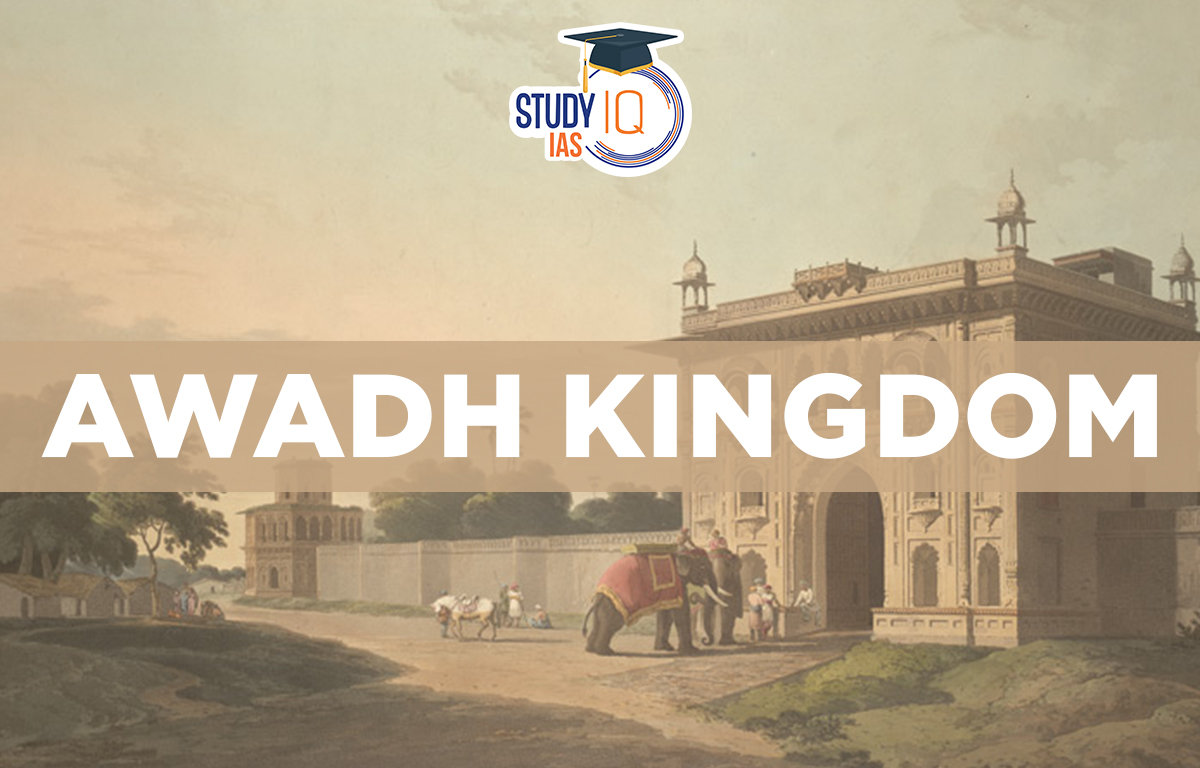Table of Contents
Awadh Kingdom
Awadh Kingdom, formerly known as the United Provinces of Agra and Oudh before independence, is a territory and proposed kingdom in the modern Indian state of Uttar Pradesh. It is also also referred to as Avadh or Oudh in British history texts. With Faizabad as its initial capital and Saadat Ali Khan as it’s first Subadar Nawab and ancestor of the Nawabs of Awadh dynasty. You will learn about the Awadh Kingdom in this article, which will help you with your preparation for the UPSC Civil Service Exam.
Awadh Kingdom History
Awadh was another Mughal province to achieve independence during the eighteenth century. Saadat Khan was appointed the Mughal governor of Awadh in 1722. The rajas and zamindars of Awadh assigned him the task of quelling uprisings. These local rajas and zamindars used to defy the Mughal government for years by refusing to pay the land tax, raising their own private armies, building forts, and more. Saadat Khan attacked them in battle.
He was successful in putting a stop to lawlessness and punishing the powerful zamindars, which increased the government’s financial resources. All of these tasks were completed by Saadat Khan in a year, and as a reward, Muhammad Shah, the Mughal emperor, gave him the title of Burhan-ul-Mulk.
Saadat Khan, however, did not like the Mughal court politics. As a result, he made the decision to consolidate his influence in Awadh and had his son-in-law Safdar Jung appointed as his deputy governor by the Mughal Emperor.
Read about: Decline of Mughal Empire
Awadh Kingdom and Jagir Administration
By reforming the jagirdari system, Saadat Khan. Jagirdars received assistance from amils, or local agents (local officials who were the representatives of the Mughal government in the different provinces). Amils was crucial to the governance of Jagir. Even if the jagirdar was relocated, the amils in Awadh were occasionally of local provenance and were allowed to remain there for an extended period of time.
In the 18th century, Amils became revenue farmers and paid the jagirdar a down payment from the revenue they would gather from the area while keeping a portion for themselves. Saadat Khan understood that the administrative reforms would not be accepted by the amils as he had hoped.
Saadat Khan thus adopted the practise of directly overseeing the amils and allocating a portion of the jagir’s income specifically for the amil’s duties. This action assisted in reducing and stifling the jagirdars’ power. Saadat Khan now directly appointed the amils, who had previously been appointed by the Mughal emperor (governor of Awadh). Chaudharis and qanungoes, the local hereditary officials, were now answerable to the amil rather than the jagirdar. The governor thereby took over the jagirdar’s authority.
Saadat Khan’s (Burhan-ul-mulk) strategy attempted to reduce the influence of the jagirdars. Despite his efforts, Burhan-ul-mulk was unable to abolish the jagir system. The Jagir system had many inconsistencies (unlawful levies, revenue farming etc.). In certain ways, his successor Safdarjung was successful in less jagirs.
Read about: Later Mughal
Awadh Kingdom Nawab
1. Saadat Khan Burhan-ul-Mulk
In the year 1722, he created the independent state of Awadh. He was chosen by the Mughal Emperor Muhammad Shah to serve as governor, and he had a significant impact on imperial affairs during the Nadir Shah invasion. He killed himself in order to lose his name and honor.
2. Safdar Jung/ Adbdul Mansur
He was Saadat Khan’s son-in-law and fought alongside him in the Battle of Manpur against Ahmed Shah Abdali (AD 1748).
3. Shuja-ud-daula
He was an ally of the Afghan Ahmed Shah Abdali and the son of Safdar Jung. By fighting Rohillas with the assistance of the British, he annexed Rohilkhnad to Awadh in AD 1774.
4. Asaf-ud-daula
He was well known for advancing Lucknow culture and creating significant structures like the Imambara and Rumi Darwaza. He joined the British in signing the Treaty of Faizabad in AD 1755.
5. Wajid Ali Shah
He was the last king of Awadh, also known as Jaan-i-Alam and Akhtarpiya, but British Lord Dalhousie captured the region because of his poor leadership. He was a fan of traditional music and dance, and there were artists there like the Kalka-Binda Brothers.
Awadh Kingdom Decline
Late in 1754, Safdar Jung passed away. Shuja-ud-daula was given the position of governor of Awadh by Alamgir II, a puppet Mughal emperor. Shuja accompanied Afghan leader Ahmad Shah Abdali as he travelled to India for the Third Battle of Panipat (1761) in an effort to demoralise the Marathas. The English East India Company presented a significant threat to Shuja-ud-Daula in 1764. (Battle of Buxar). This was the last straw for Awadh’s independence.
Awadh Kingdom UPSC
Only in the late 16th century, during Akbar’s Mughal era, is modern Awadh referenced in historical accounts. The term Oudh, or Awadh, appears to have been used to refer to just one of the ancient divisions or Sarkars, roughly equivalent to old Pachhimrath. The boundaries of the subah (imperial top-level province), as well as its internal divisions, appear to have changed frequently from prehistory until Akbar’s reign.
When British India was annexed in 1858, it seems to have been around the same size as the Province of Oudh. The Awadh Kingdom is fully described in this article for UPSC exam preparation.


 Maharashtra’s Mendrachi Vancharai Syst...
Maharashtra’s Mendrachi Vancharai Syst...
 Keeladi Excavation: Uncovering the Ancie...
Keeladi Excavation: Uncovering the Ancie...
 Sanyasi Revolt, Objectives, History, Rea...
Sanyasi Revolt, Objectives, History, Rea...





















